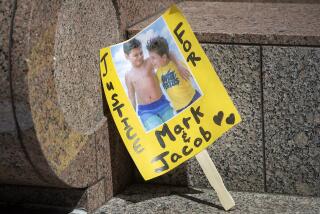Jury Told Weller Must Pay for Killing 10
- Share via
Jurors should believe dozens of Santa Monica residents who saw George Weller repeatedly turn the wheel, hit the brakes, and accelerate his car through a farmers’ market three years ago, the prosecutor said Thursday.
If Weller could see and steer, he could have stopped before killing 10 pedestrians, Deputy Dist. Atty. Ann Ambrose said in closing arguments in Weller’s manslaughter trial.
The prosecution closed its case against Weller, now 89, on Thursday. The defense is to finish its closing arguments today, and the jury will begin deliberations.
Los Angeles County Superior Court Judge Michael Johnson instructed jurors to reach a verdict “without pity or prejudice.”
The defense in the three-week trial contended that Weller hit the accelerator when he meant to hit the brake -- which caused unexpected acceleration and panic so extreme that he could not reverse course before leaving almost 1,000 feet of carnage along Arizona Avenue at the Santa Monica Farmers’ Market more than three years ago.
“The defendant is charged with driving his vehicle in a grossly negligent manner, for whatever reason,” Ambrose said. The cause -- “pedal error,” or running from a minor accident, as some witnesses testified -- is unimportant, she said.
Ambrose said only eyewitnesses are completely reliable, but defense attorney Mark Overland urged jurors to trust expert witnesses, mostly state and federal officials.
“Every single expert in this case reached the same conclusion,” Overland said. “It was unprecedented, it was horrific, it had never happened before, but it was an accident nonetheless.”
Ambrose told jurors they should determine what Weller could have done “on that day, what did he do on that day and what he failed to do as he drove to that market and through that market in taking the lives of 10 victims.”
“Whether or not you believe pedal error is the best explanation, it is only an explanation,” Ambrose said. “The law doesn’t say you can kill 10 people if you did it because you weren’t paying attention because you stepped on the wrong pedal.”
Ambrose projected large pictures of the dead and dying sprawled at the market, interspersed with the expression, “OOPS!”.
She liberally quoted witnesses who said Weller was intent, calm, unconcerned and dismissive as he stood on the sidewalk after his car came to a stop. In a statement hours later to police, Weller apologized and expressed concern for the victims, but “his attitude was one of complete indifference,” Ambrose argued.
“He’s relaxed, he laughs, he laughs out loud at different times,” Ambrose said. “He says ‘those poor, poor people,’ but he spends much more time talking about what [epithets] people called him.
“He spent more time reminiscing about the building of the 101 Freeway than he does about the people he left on the street, bloodied,” she said.
Overland urged jurors to conclude that the incident was a mistake, not a crime.
“The law doesn’t require him to be infallible. The law does not require him to act without making mistakes,” Overland said. “The law does not require perfection.”
To be negligent or reckless, Overland said, the results must be foreseeable.
“Could he have foreseen the disaster and destruction of going through the market when he was involved in the fender-bender?” Overland asked.
Weller may not have intended to kill 10 people, Ambrose said. “But when you choose to get behind the wheel of a car, whether you are 16 or 86, you have duty to maintain control,” she said. “Failure under these circumstance is criminal conduct, and you must be held responsible.”
Earlier Thursday, in a major win for the prosecution, Johnson ruled that jurors will be allowed to find Weller guilty of misdemeanor manslaughter, as well as the more serious crime of felony vehicular manslaughter. The latter, punishable by prison, requires a finding of gross negligence, but the former only common negligence or carelessness.
Only a few crash survivors attended the trial in the Criminal Courts Building downtown, and Weller came on the opening day.
More to Read
Sign up for Essential California
The most important California stories and recommendations in your inbox every morning.
You may occasionally receive promotional content from the Los Angeles Times.













